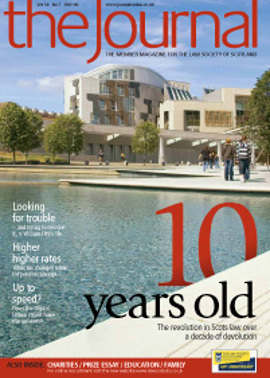The greater good

In June of this year, as a result of an extensive four month programme of research, the Charity Commission for England & Wales launched an initiative entitled “The Big Board Talk... the conversation all charities need to have”, in which they challenged charities to ask themselves a series of difficult questions.
One of those questions, in the section dealing with governance, asks: “Have we considered collaborating with other charities?” and specifically urges trustees to “consider the possibility of a formal merger with another charity or charities in the interests of [their] beneficiaries”.
Type of merger or collaboration
Before taking a look at some of the particular legal issues involved, it is worth considering the form any potential merger or collaboration might take. The charities involved may be contemplating a merger in the true sense of the word, where one new charity is to be formed and two or more existing charities are to transfer their assets into the new charity, and thereafter wind up – model A; or the charities may simply be considering the transfer of assets from one “donor charity” to an existing “donee charity” where, once the transfer of assets has taken place, the “donor charity” winds up and the “donee charity” is in the same position as the new charity in the first scenario – model B.
KYC – “Know your constitution”
KYC is a well known acronym among those involved in the delivery of professional services as meaning “Know your client”, but it can equally be applied to legal advisers advising charity trustees in connection with their constitution, deed of trust, royal charter and statutes, or memorandum and articles of association. Here, the advice is to “Know your constitution” – or indeed your client’s constitution.
Power to merge?
Whether the form of merger which is being proposed is model A or model B, it is important to consider whether the charities have the requisite powers in their constitutions to do so, and whether that is a specific power to merge or to wind up. The terms of the power should also be considered: for example, when contemplating a model B merger, are the terms of the wind-up clause restrictive at all? Do the charitable objects of the donee charity have to be the same as, or similar to, those of the donor charity?
The lack of a specific power to merge or any restriction on the terms of the wind-up clause is not fatal, but rather can be cured by the use of the reorganisation provisions set out in Chapter 5 of the Charities and Trustee Investment (Scotland) Act 2005, whereby either or both merging charities could seek to have the missing power inserted into an existing constitution, or the wind-up power amended. Indeed the merger itself can be effected as part of a reorganisation.
Suitable objects
Notwithstanding the terms of any power to merge or wind up, it is necessary to consider the charitable objects of the merging charities. Are they sufficiently similar to allow the Office of the Scottish Charity Regulator (OSCR) to grant consent to the merger without insisting that the assets of the charities pass by means of a restricted fund? Such a result would probably be an unwelcome consequence for the new charity since it may find that it is unable to use the assets being transferred to it as freely as had been hoped. Reorganisation provisions in the Act could be used to align the charitable objects of the merging charities to avoid such an outcome.
Best interests
Having established that, in terms of the constitution, there is the power to merge or alternatively that any lack of power can be cured, the charity trustees must then decide that to do so is in the best interests of the charity – or indeed its beneficiaries.
The general duties of charity trustees are set out in s 66 of the Act which, in subs (1), states: “A charity trustee must...
- (a) seek, in good faith, to ensure that the charity acts in a manner which is consistent with its purposes,
- (b) act with the care and diligence that it is reasonable to expect of a person who is managing the affairs of another person, and
- (c) in circumstances capable of giving rise to a conflict of interest between the charity and any person responsible for the appointment of the charity trustee – (i) put the interests of the charity before those of the other person, or (ii) where any other duty prevents the charity trustee from doing so, disclose the conflicting interest to the charity and refrain from participating in any deliberation or decision of the other charity trustees with respect to the matter in question.”
It ought to be noted that these specific duties are in addition to all other duties of trustees in terms of the common law or in statute, the most important of which may be the statement of directors’ duties contained in the Companies Act 2006 for those charities which are companies limited by guarantee.
Taking each of the s 66 duties in turn:
- (a) acting in a manner consistent with its purposes
In considering the form which any proposed merger might take, the charity trustees can be seen to be complying with s 66(1)(a). While “purposes” means the charitable purposes set out in the body’s constitution, the charity trustees might also seek to take account of any wishes of the settlor perhaps not written in the constitution, but informing the way the charity operates, so long as that is consistent with the charitable purposes.
- (b) acting with due care and diligence
This is a higher standard than that expected of an individual looking after his or her own affairs. The merging charities will have to carry out a due diligence exercise, examining the assets and liabilities of the other charity to ensure so far as possible that there are no “hidden surprises”. This can be a lengthy and potentially expensive process and may involve charities disclosing otherwise confidential information. At this stage, the proposed business plan of the new charity will also require to be considered and the charity trustees must be satisfied that they are transferring their charity’s assets to a body that will not, for example, run into financial difficulties in a short time. How to deal with any potential income stream from legacies should also be considered. This is discussed in more detail in the panel.
- (c) conflicts of interest
Finally, the charity trustees will have to consider whether any conflicts of interests exist. Particular difficulties might arise where an individual is a charity trustee perhaps of the prospective board of trustees of the new charity where model A is being used and of one of the merging charities. Any such conflicts should be documented carefully and managed properly to ensure that any trustees’ decision is beyond challenge.
OSCR and timings
It is important not to lose sight of the various timing issues which must be built into any plan to merge, once a prospective date is fixed. An early approach to OSCR might be prudent to ensure that the route to merger is an acceptable one and that any complex issues can be considered and expectations managed from the outset. Time should be allowed for further discussion and amendments after consulting with OSCR.
In short, in terms of s 16 of the Act, OSCR requires not less than 42 days’ notice of a proposal specifying the date a charity intends to merge, wind up or dissolve. If within 28 days of the date on which notice is given, OSCR neither consents nor refuses, OSCR is taken to have consented to the proposal. Alternatively, OSCR might consent actively, refuse its consent or direct the charity not to take action for six months all as specified in the direction.
Other considerations
In addition to the legalities and practicalities mentioned, when considering a merger, we would also recommend that a charity considers the wider issues. Change is always difficult to manage, and where there is a large volunteer group it will be important to engage with them at an early stage to ensure their support. The views of substantial donors might also be canvassed as there may be those who regard a proposed merger as more of a takeover and could potentially take their much valued support elsewhere.
A merger of two charities can throw up a number of difficulties and unforeseen complexities, so if it is considered the best course of action, then the long-term future of the merged charity should be mapped out clearly in early discussions. It may not be the easiest route for charities to choose, but in the current economic climate, merging may just provide the answer to a difficult question.
Potential legacy income
As is the case with many charities, retaining legacy income was a key consideration for the Age Concern charities and Help the Aged during their merger process. With the expectation that one or more charities will cease to exist following a merger, regard must always be had to any potential legacy income. Charity trustees cannot rely only on the existence of will clauses which provide that, where a charity has merged with another or ceases to exist, the executors of the deceased have the discretion to pay the legacy perhaps to the newly formed charity.
Ideally, the charity must remain on the Scottish Charity Register to collect the legacy income. However, in terms of the Act, to do so it must provide public benefit. Public benefit is not presumed in a Scottish context and this may be problematic if there is no activity other than the potential collection of legacies at some point in the future. OSCR has the power to remove dormant charities from the register following a period of inactivity, but as yet no guidance exists as to how and to what extent potentially dormant charities will have to show public benefit. Presumably OSCR would not wish legacies to be lost to the charity sector.
In this issue
- Solicitor advocates: the future
- For the love of it
- Not to be denied
- Ten years on
- Never say never
- MD becomes new Keeper
- Whose view prevails?
- Scant relief?
- The greater good
- Twenty out of ten
- First class
- Clean break
- Ask Ash
- Not quite switched on
- Beware salary waiver tax traps
- Road to recovery?
- ASBOs: what standard?
- Scotland the unready
- The limits of listing
- Debt traps
- Tread warily
- Scottish Solicitors' Discipline Tribunal
- Website review
- Book reviews
- Procurement remedies take shape
- Clauses become more standard






